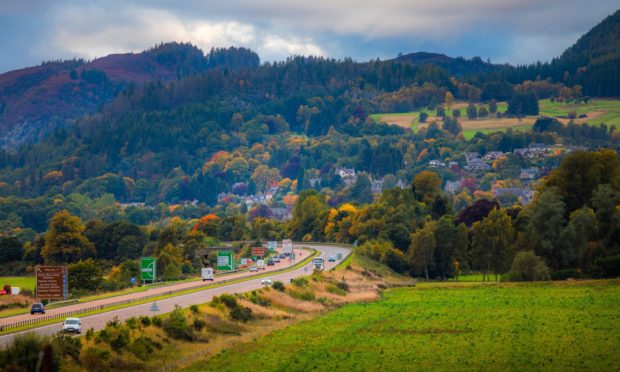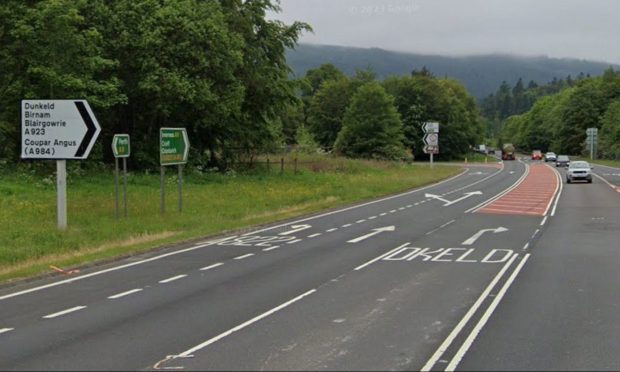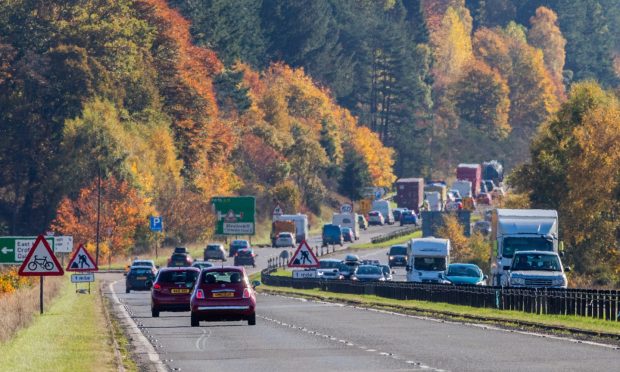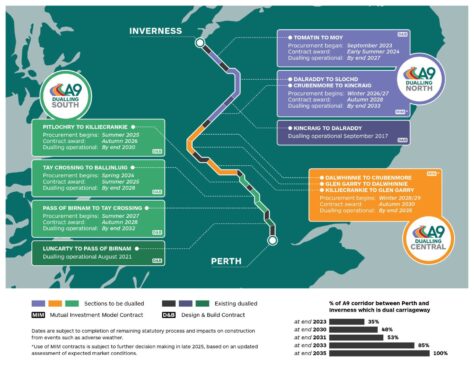Perthshire campaigners are hugely frustrated after the latest delay to the long overdue promise to complete the dualling of the A9.
The new 2035 timetable means there will be another 12 years before the final section of the route between Perth and Inverness is upgraded.
It comes as a major blow for communities who fear lives will continue to be lost in the meantime on the dangerous road.
Here’s what transport chief Màiri McAllan’s announcement last week means for various sections of the road due to be widened across Perthshire.
Pass of Birnam to Tay Crossing – due to be completed in 2032
An 8 km stretch of the A9 which passes through Dunkeld is the southernmost part of the road which has been bogged down by missed deadlines for dualling.
The route, from just before Birnam to the Tay Crossing, has been at the centre of safety concerns and demands from residents for a new roundabout.
Ms McAllan confirmed last Wednesday that work to find a contractor will only begin in 2027, two years after the whole scheme should have been finished.
Should all go well then work will start the following autumn, but construction will not be completed until 2032.
That is of huge concern to campaigners in the area, who say they will need to keep pushing for safety improvements over the next decade.
David Bee, a member of the Dunkeld and Birnam Action Group, told us: “It’s good to have a plan.
“But we’re talking about a decade if all goes well, and potentially much longer than that.”
He insists police need more resources to enforce a 50mph speed limit on the single-lane stretch of the road to keep drivers safe.
However, campaigners welcomed confirmation from the government that new roundabouts, including in Dunkeld, will be introduced.
Following last week’s announcement the SNP also said a preferred route for constructing the dual carriageway had been chosen after talks with locals.
Since new roundabouts are being built and junction layouts will be changed the Scottish Government has acknowledged this will be a “challenging section” to dual.
One owner of a popular takeaway has been forced to move his business to a new site in Dunkeld due to the project.
It’s estimated upgrading this section of the road will cost £478 million, a significant chunk of the government’s £3.7 billion budget.
Tay Crossing to Ballinluig – due to be completed in 2028
Residents slightly further north can expect to see the route between the Tay Crossing and Ballinluig dualled by an earlier date.
Work to find bidders for this 8.2 km stretch of the road will begin as soon as next spring, to ensure widening can start the following summer.
It’s hoped upgrades can be completed by the end of 2028, making it the next section of the A9 in Perthshire which should be fully dualled.
Campaigners were left unsurprised when it emerged the target to finish the job by 2025 would no longer be met.
Alasdair Wylie, coordinator of the fight to dual the route, described delays to the programme as “intolerable” earlier this year.
Currently it’s estimated this stage of the project will cost £222 million.
Pitlochry to Killiecrankie – due to be completed in 2030
Further north, efforts to find a contractor for 6.4 km of road between Pitlochry and Killiekranie will start in summer 2025.
Ms McAllan said she hopes the programme to upgrade the route can then get underway in autumn the following year.
If everything goes to the plan the small section of the road will be fully dualled by the end of 2030.
That will be a significant landmark since it will be the exact point at which more than half of the scheme to widen the A9 has been completed.
As of right now, this is expected to cost £296 million.
Killiecrankie to Dalwhinnie – due to be completed in 2035
Two of the 11 planned upgrades for the A9, which connect Perthshire with the Highlands, will be among the last to be finished under the new timetable.
Dualling from Killiecrankie to Glen Garry, and from Glen Garry to Dalwhinnie, are not scheduled to be completed until 2035.
Efforts to find constructors will not begin until 2028 at the very earliest, and work will not start until around seven years from now.
A small stretch of road between the two stages of the project is already dualled.
The preferred plan for dualling the route in this area has proven particularly controversial since it will cut through a historic battlefield.
A layby near Killiecrankie will be built over the very heart of where bloody fighting took place during a Jacobite uprising in 1689.
Objections from campaigners were rejected since paving through an alternative route would have been much more expensive.
Mid Scotland and Fife Tory MSP Murdo Fraser slated the SNP for lengthy delays to completing the scheme.
He said: “Too many lives have needlessly been lost, and more will die as a result of the further delays.
“At best we will be waiting another 12 years, and that’s if it meets these new targets.”
Ms McAllan acknowledged that progress on delivery had been slow.





Conversation